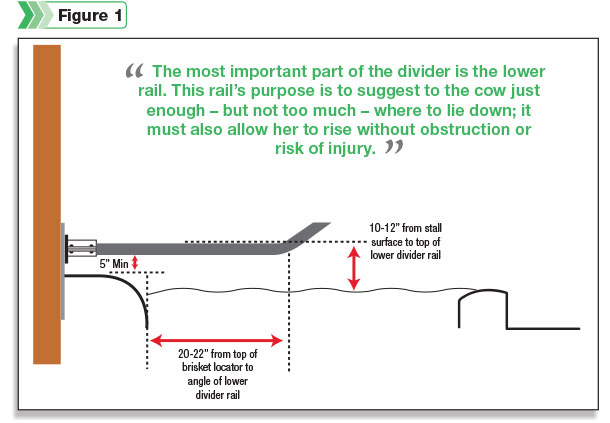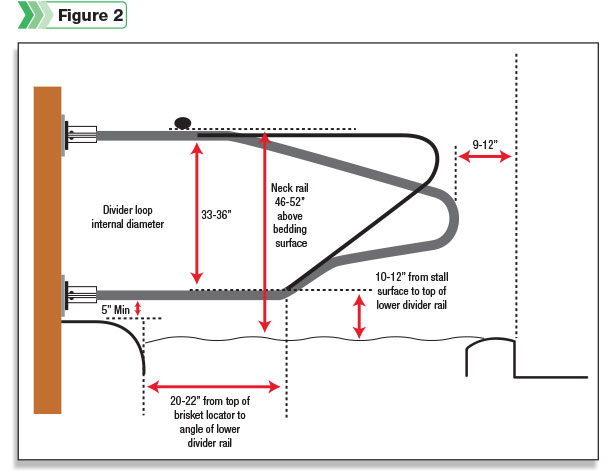Freedom stalls, green stalls, Michigans, dog bones, wide loops, narrow loops – there is seemingly an endless list of different ideas for freestall divider designs that dairy producers have to sort through when making a building choice.
In this article, I will try to break down the anatomy of a divider loop to understand the design and function of each part so we can make the right choice to optimize cow comfort and hygiene.
The freestall divider has a number of functions, including:
1. Defining the lateral limits of the resting space
2. Facilitating lying direction of the cow – straight rather than diagonal
3. Permitting or preventing side lunge
4. Determining the height of the neck rail
Obviously, it is preferable if the divider performs these functions without injuring the cow, and I will make the assumption that we are going to provide the cow the necessary space to rest comfortably using the latest recommendations for stall length and width. The measurements I will use in this article refer to a typical Holstein cow, weighing 1,400 to 1,600 pounds.We will also mount the dividers to avoid obstructions in the lunge space in front of the stall.
The most important part of the divider is the lower rail. This rail’s purpose is to suggest to the cow just enough – but not too much – where to lie down; it must also allow her to rise without obstruction or risk of injury.
The height of the lower rail is critical. It must allow for at least a 5-inch gap between the lower edge of the bar and the top of any brisket locator. This will prevent any front-leg entrapment below the rail. It must also be high enough, but not too high. Low divider rails allow cows to rise with their front legs over the lower rail – leading to entrapment and a cow caught in the middle of the loop.
High divider rails will at some point prevent side lunge into the adjacent stall unless they are so high that the cow lunges below them – such as the Michigan or dog-bone loop design.
If the stall is long enough to permit front lunge, a lower rail that prevents side lunge is perhaps permissible. However, on head-to-head stalls, cows in the opposite stall may pose a social obstruction to a subordinate cow – creating a desire to side lunge even when there is space provided.
For that reason, my preference is to use a divider that allows side lunge; however, I do not believe that we should use a divider and stall design that only permits side lunge.Cows that front lunge lie straight in the stall and are cleaner.
The height of the lower rail above the level stall surface (or rear point of the curb in a deep loose-bedded stall) should be between 10 and 13 inches, typically 11 to 12 inches for mature Holstein cows. The rail should be level and not angle down to the surface, as this type of loop will promote side lunge and diagonal lying as the cow takes advantage of the lower rail height at the front of the stall.
Loops designed for side lunge, where the cow lunges below the lower rail, also promote diagonal lying, dirty stalls and medial hock injuries, and are therefore not recommended. 
The lower rail should extend back toward the rear curb enough to suggest where the cow should lie straight in the stall – but not so far back that the rail impacts the hooks and rump of the cow as she lies down, before it angles upward and out of the way. From measurements we have taken from countless stalls, we recommend that the angle be 20 to 22 inches toward the rear curb back from the brisket locator.
Since the location of the brisket locator will range typically from 68 to 72 inches from the rear curb, and stall length may vary, we need different-sized loops for different-sized stalls.
The lower rail is the most important part of the divider; it determines the lateral limits of the resting space, prevents diagonal lying and allows or prevents side lunge. The rest of the design is relatively easy.
We prefer dividers that are loops with a level or angled upper rail. The angle allows the cow to pivot her head out of the stall, when she is leaving, a little easier. The open diameter of the loop determines the height of the neck rail.
A distance of 33 to 36 inches from the upper edge of the lower rail to the lower edge of the upper rail should locate the neck rail at the target height of 46 to 52 inches – depending on the size of the cow. 
Neck rails determine the standing position of the cow in the stall, and they are always in the way since cows usually step forward when they rise. However, in a correctly designed stall, provided we have sufficient height, cows will adapt and step backward if we make sure there are no other obstructions to the normal rising movement of the cow.
Lastly, the rear limit of the divider should be 9 to 12 inches inside the rear curb – close enough to prevent cows from walking along the back of the stalls but not so close that it gets hit by passing machinery.
Hopefully this article leads to better divider loop decisions to maximize cow comfort and reduce the risk for injury. PD
Nigel Cook is currently chair of the Department of Medical Sciences at the University of Wisconsin – Madison School of Veterinary Medicine and manages the Dairyland Initiative.







